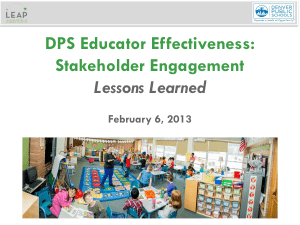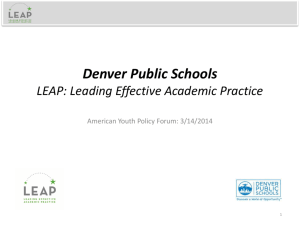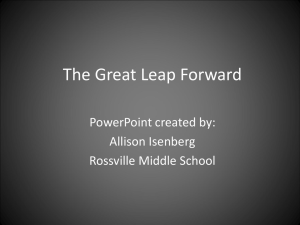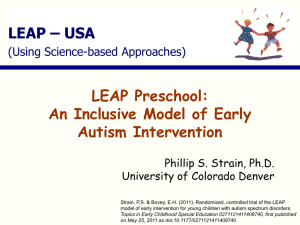Click here to view part 2 of the presentation slides
advertisement
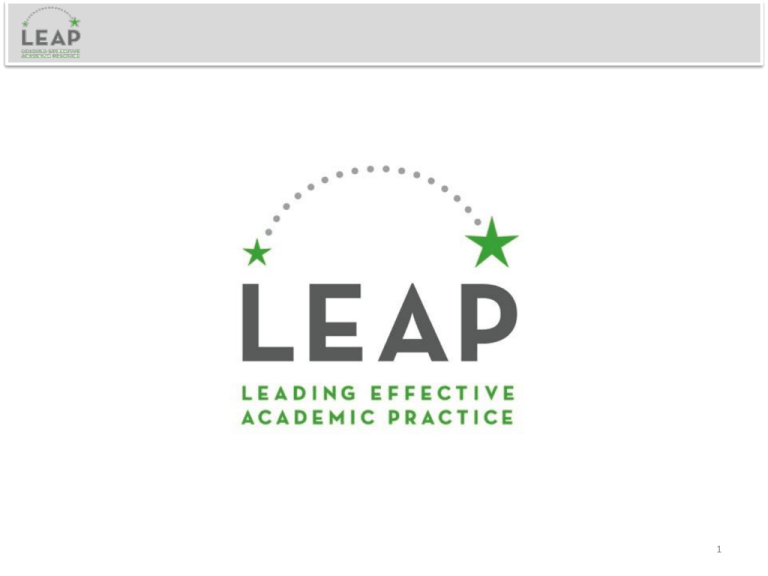
1 Where We’ve Been 2010 - 11 • Piloted evaluation components and process at 16 schools • Developed DPS definition of teacher effectiveness • Engaged principals and teachers in system design • Build organizational capacity through principal professional development and Teacher Leader Academies • First student survey • (SB 10-191 passed) 2011-12 • Piloted LEAP in 94% of DPS schools • Peer Observer team formed & performs additional teacher observations. • Refined system based on MET research findings • Aligned PD resources to Framework • Piloted Student Perception Surveys 2012-13 • LEAP at 100% schools • Revised Observation Framework from 21 to 12 Indicators • Teachers received indicator level results for all three Domains of the Framework (Instruction, Learning Environment, Professionalism) • Re-aligned PD resources to Framework and added Closer Looks • Professionalism scores received for first time 2013-14 • LEAP at 100% schools • All LEAP Observers calibrated & certified • Final LEAP rating given & reported to state using matrix • Revised Professionalism framework • Differentiated TL roles to support LEAP & support structures at 14 schools • Piloting SLOs at 15 schools • Piloting Specialized Service Provider Evaluation system • Work continues on differentiated PD. 2 LEAP Components • Final scores for each side calculated based on formulas. • Matrix approach used to combine sides into a final rating. 3 MET Guiding Principles MEASURE EFFECTIVE TEACHING ENSURE HIGH QUALITY DATA INVEST IN IMPROVEMENT • • • • • • • • Set Expectations • Use multiple measures • Balance weights • Monitor validity • Ensure reliability • Assure accuracy • Make meaningful distinctions • Prioritize support and feedback • Use data for decisions at all levels Developed The Framework for Effective Teaching as the basis of our shared definition of effective teaching Multiple measures at balanced weights for each component of the system More than one observer to increase reliability Systems developed to ensure rosters are accurate and properly attributed to teachers Observer training and certification process Using multiple (three) years of data on student achievement gains Master coded videos modeled after the MET Master Coding Boot Camp 4 Feedback Structures DCTA on LEAP Steering Committee, Student Outcomes Working Group, SLO team and working groups, and SSP Evaluation pilot representation. Two DCTA liaisons are part of the DPS project team Our DCTA Teacher Outreach Manager visits schools to collect feedback and share information throughout the district in a variety of venue. The team responds to feedback and shares changes to system through newsletters and the LEAP website Collaborative and iterative program design with changes based on feedback and data analysis through multiple years of design. DCTA DCTA Liaison and Outreach Managers 42 school leaders and teachers on 5 design teams selected through an application process 5 Design Teams meet regularly to provide feedback and inform design. Newsletters, Websites Focus Groups Multiple Years of Design Faculty Meetings LEAP Hotline & Website Operations team responds to all feedback from the website, or via e-mail or hotline, within 24 hours Teacher Leaders Teacher Leaders across the district meet monthly. 23 separate focus groups launched the design phase. We continue to hold focus groups across the district as needed to collect feedback. LEAP team members attend faculty meetings at schools across the district with Tom Boasberg (Superintendent) and Susana Cordova (CAO). Faculty meetings are a two-way dialogue to talk with our educators, collect feedback on district priorities and answer questions. 5 Implementation and Support Alignment of Professional Learning resources to LEAP • Professional Learning aligned to Framework indicators, ongoing work to differentiate learning to teacher effectiveness levels (PD aligned to indicators) • School building leaders and teachers select indicators for focused Professional Learning at a building and individual level (Professional Growth Plans) • Structured observation feedback conversations with next steps for growth. • Partial and walkthrough observations allow for more frequent observations on targeted indicators. • Professionalism (offstage) is discussed in mid-year conversations with opportunity to grow and improve prior to final ratings at end of year. Using LEAP data to inform entire teacher lifecycle • Use to evaluate pipelines, inform screenings and predict effective teachers • Inform new teacher induction, mentoring, professional learning • Support teachers to become effective through feedback and aligned support • Career lattices and teacher leadership • Identification of teachers for remediation plans 6 STUDENT PERCEPTION SURVEY 7 Evolution of Student Perception at DPS Spring 2011 2011-12 2012-2013 2013-2014 Tripod survey piloted in 16 schools DPS-modified survey piloted in 127 schools Survey expanded to include questions on rigor (9-29 Q’s) ECE-2 survey eliminated . Grades 3-5 and 6-12 survey content combined to a single survey • Feedback: • Too long (75+ questions) • Not specialized for ELLs, ECE, or Special Education • Shortened survey administered for 2,941 teachers (9-22 Q’s, based on grade level) • Modifications in survey and administration to support ECE, ELLs, and Special Education students • Spring 2012 survey administered for 1,713 teachers • Separate surveys for grades 3-5 and 6-12 with differentiated content • All LEAP schools participated in grades 3-5 and 6-12 surveys • Survey for grades ECE-2 piloted (optional) • 61,277 survey responses results for 2,829 teachers • Survey administered in fall only Reduced burden on students, teachers & staff • Fall administration window lengthened and spring makeup window added • Prior to the makeup window had 79,000 survey responses and results for 2,877 teachers (final results available in April). • SPS scores used in LEAP ratings for first time (10%) Increased flexibility for teachers and schools 8 2013-14 Revisions to Survey Administration 2012-13 Survey administration window Days for schools to administer Classes surveyed Proctoring Revised (2013-14) Rationale Nov 13 – Nov 30 3 weeks Oct 23 – Nov 22 (4 weeks) Makeup window: Feb 10 – Feb 28 (3 weeks) 1-3 consecutive days within window As many days as needed within window Days do not need to be consecutive Elementary – homeroom Elem/Middle Specials – 1st class on administration days Secondary – 2nd period Same, but: Specials and secondary teachers have option to administer survey to 1 additional class Provides specials and secondary teacher with larger proportion of total students to survey (elementary teachers survey all students) Teachers may administer to their own classes Recommend that someone other than teacher administers: e.g., other teachers, administrators, paras, students (high schools) Reduces inconsistencies in administration Avoids potential bias in student responses Allows schools more flexibility in administering surveys for all teachers Accommodates variety of scheduling practices and circumstances 9 Questions and Constructs Survey items were revised with input from teacher focus groups, discussions with Teaching and Learning and DCTA. – Revising wording that may be difficult for students to interpret consistently (e.g., “concepts” changed to “ideas”) – Revising or removing items that are not applicable to all teaching contexts (e.g., questions specific to homework and writing notes on students’ work) – One list of items for all grade levels. Our questions align to 3 constructs: 1. Facilitates Learning: Support and facilitation of student learning. 2. High Expectations of Students: Expectations for student behavior, including effort (includes both classroom management type items and high expectations for learning) 3. Supports Students: Teacher-student relationship focused on emotional and psychological support. 10 Scoring and Reporting of Results • Teachers and School Leaders access reports online within 6 weeks of administration. • Scoring based on % positive (Most of the Time or Always responses) • Grouped into quintiles for reporting as no LEAP ratings are given at the measure level. • Individual teacher data compared to District and School % positive • Data reported at school and teacher level, and disaggregated by: – Category and Question – Demographic data (ethnicity, gender, ELA, SPED) – Response distribution • At the end of the year scores are combined with other measures to give a teacher their summative LEAP rating. 11 Supports, Alignment, and Next Steps • Teachers discuss results with school leaders in mid-year conversations. • Results are a part of a holistic conversation that encompasses all LEAP data to date, including Observation and Professionalism. • Recommendations and guiding questions provided to school leaders, team leaders, and teachers in training materials (how to look at results in the context of other LEAP data). • Data analysis of alignment to other measures is ongoing. • Teachers who received additional Observation support though Differentiated Teacher Leaders saw a 1% average increase in scores over expected, the Teacher Leaders saw a 2% average increase. • Next steps for development: – Best practice recommendations and materials for involving students more deeply – Formal Professional Learning materials correlated directly to Student Perception Survey results 12 Survey Alignment with MET MET Recommendations DPS LEAP System Measure what matters: Questions focus on what teachers do, and on the learning environment they create. Revisions on questions based on results, extensive feedback, external review, and statistical analysis to ensure questions are relevant and appropriate. Ensure accuracy: Student responses should be honest and based on clear understanding of questions. Confidentiality is a must. Continued examination of administration protocols. Administration based on state testing protocols for confidentiality and recommend teacher does not administer. Ensure reliability: Reliability requires adequate sampling and number of items so teachers have confidence that surveys can produce reasonably consistent results. We found no statistical difference in 2 administrations a year and reduced to one administration and one make-up administration to reduce impact on instructional time. Added a second optional administration class period for teachers. Support improvement: Teachers should receive results in a timely manner, understand what they mean, and have access to PD. Teachers and school leaders have access to results online approximately a month after administration during mid-year conversations. We are still working on supports for improvement. Source: Asking Students about Teaching: Student Perception Surveys and their Implementation (2012) 13 Engaging Students in the Educator Effectiveness Conversation: Building a Robust Student Perception Survey May 1, 2014 OVERVIEW • Why use a Student Perception Survey? • What the Research Says • Survey Overview • Survey Development • Pilot Results • Survey Administration • Use of Survey Results Building a Robust Student Perception Survey

